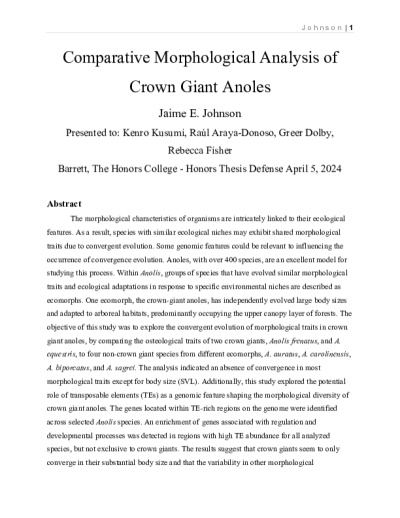Matching Items (4)
Filtering by

Description
Three populations of experimentally evolved Drosophila melanogaster populations made up of high temperature (H, constant 25 ᵒC), low temperature (C, constant 16 ᵒC) and temporal homogeneity (T, environment changes between 16 ᵒC and 25 ᵒC) were prepared and assayed to determine difference in citrate synthase activity. Between the three groups, the results were inconclusive: the resulting reaction rates in units of nmol min-1mgfly-1 were 81.8 + 20.6, 101 + 15.6, and 96.9 + 25.2 for the hot (H), cold (C), and temporally homogeneous (T) groups, respectively. We conclude that the high associated variability was due to a lack of control regarding the collection time of the experimentally evolved Drosophila.
ContributorsBelohlavek, David (Author) / Angilletta, Michael (Thesis director) / Francisco, Wilson (Committee member) / Barrett, The Honors College (Contributor) / Department of Chemistry and Biochemistry (Contributor)
Created2015-05

Description
The Cannabis plant has historical roots with human beings. The plant produces compounds called cannabinoids, which are responsible for the physiological affects of Cannabis and make it a research candidate for medicinal use. Analysis of the plant and its components will help build a better database that could be used to develop a complete roster of medicinal benefits. Research regarding the cellular protein receptors that bind the cannabinoids may not only help provide reasons explaining why the Cannabis plant could be medicinally relevant, but will also help explain how the receptors originated. The receptors may have been present in organisms before the present day Cannabis plant. So why would there be receptors that bind to cannabinoids? Searching for an endocannabinoid system could help explain the purpose of the cannabinoid receptors and their current structures in humans. Using genetic technologies we are able to take a closer look into the evolutionary history of cannabinoids and the receptors that bind them.
ContributorsSalasnek, Reed Samuel (Author) / Capco, David (Thesis director) / Mangone, Marco (Committee member) / Stump, Edmund (Committee member) / Barrett, The Honors College (Contributor) / School of Life Sciences (Contributor)
Created2014-05

Description
The modern tetraploid species Gossypium barbadense L. (AD2) traces its origins to an allopolyploidy event between diploid progenitors G. raimondii (DT Genome, Americas) and G. herbaceum (AT Genome, Asia/Africa). In this study, nine fiber-related genes consisting of seven MYB transcription factors, a cellulose synthase homolog, and a tubulin homolog were resequenced across 54 G. barbadense lines spanning the wild-to-domesticated spectrum. Tests for nucleotide diversity (π), linkage disequilibrium (LD), and Tajima’s D were performed to examine the extent to which evolutionary forces have acted on these nine loci in G. barbadense. Results indicated that the AT-genome loci had significantly higher levels of diversity and lower levels of LD relative to homoelogous loci from the DT-genome. Additionally, all loci showed signatures of a population size expansion after a bottleneck or selective sweep and/or purifying selection. As previously shown for a sister tetraploid taxa (G. hirsutum), gene conversion resulting from a DT-genome allele invasion into the AT-genome likely explains the higher levels of diversity and lower levels of intragenic LD in the AT-genome. Given the relatively very low level of genetic diversity in elite lines, introduction of novel alleles from wild, land race, or obsolete lines into modern Pima cotton breeding programs is needed to expand the narrow gene pool of G. barbadense for continual yield improvements.
ContributorsNadon, Brian Davis (Author) / Gaxiola, Roberto (Thesis director) / Kusumi, Kenro (Committee member) / Dyer, John (Committee member) / Barrett, The Honors College (Contributor) / School of Life Sciences (Contributor)
Created2013-05

Description
The morphological characteristics of organisms are intricately linked to their ecological features. As a result, species with similar ecological niches may exhibit shared morphological traits due to convergent evolution. Some genomic features could be relevant to influencing the occurrence of convergence evolution. Anoles, with over 400 species, are an excellent model for studying this process. Within Anolis, groups of species that have evolved similar morphological traits and ecological adaptations in response to specific environmental niches are described as ecomorphs. One ecomorph, the crown-giant anoles, has independently evolved large body sizes and adapted to arboreal habitats, predominantly occupying the upper canopy layer of forests. The objective of this study was to explore the convergent evolution of morphological traits in crown giant anoles, by comparing the osteological traits of two crown giants, Anolis frenatus, and A. equestris, to four non-crown giant species from different ecomorphs, A. auratus, A. carolinensis, A. biporcatus, and A. sagrei. The analysis indicated an absence of convergence in most morphological traits except for body size (SVL). Additionally, this study explored the potential role of transposable elements (TEs) as a genomic feature shaping the morphological diversity of crown giant anoles. The genes located within TE-rich regions on the genome were identified across selected Anolis species. An enrichment of genes associated with regulation and developmental processes was detected in regions with high TE abundance for all analyzed species, but not exclusive to crown giants. The results suggest that crown giants seem to only converge in their substantial body size and that the variability in other morphological characteristics could be attributed to some other ecological features or the phylogenetic relationships of each species. Moreover, TEs may play a role in facilitating morphological evolution and adaptability in all Anolis species, as they could influence gene expression and regulatory pathways. This highlights the need for further investigation into the genomic mechanisms determining convergent evolution.
ContributorsJohnson, Jaime (Author) / Kusumi, Kenro (Thesis director) / Araya-Donoso, Raúl (Committee member) / Dolby, Greer (Committee member) / Fisher, Rebecca (Committee member) / Barrett, The Honors College (Contributor) / School of Life Sciences (Contributor)
Created2024-05